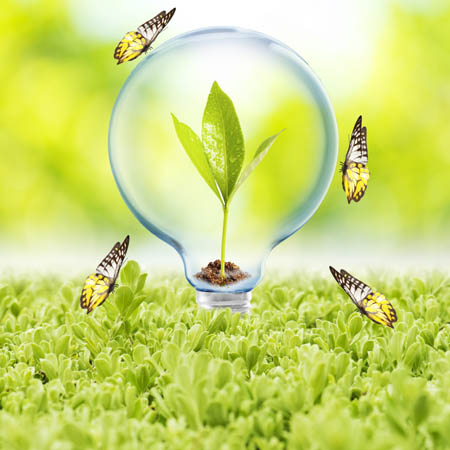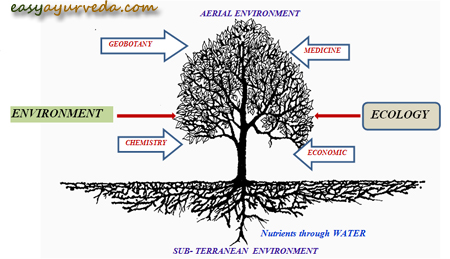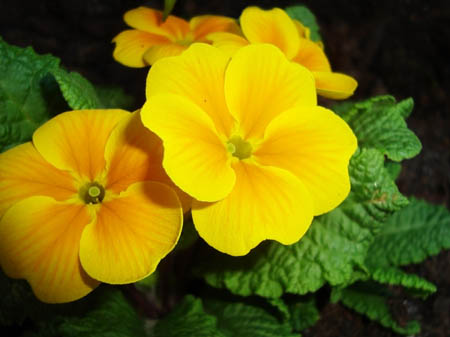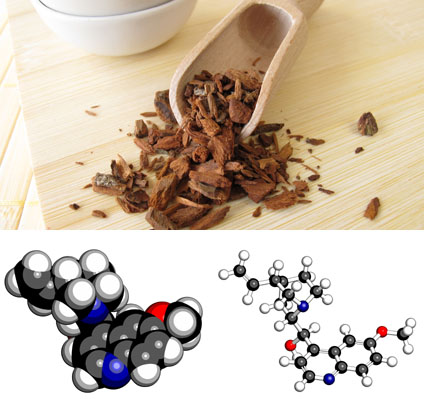Plants – Most Incredible Gift Of Mother Nature
Article by AK Shyam.
Plants have provided solutions to many a problem in the past and no wonder humans keep looking into plants for their solutions. The variety of species (Natural) packed in a unit area co-exist without any complaint – the beauty is that the character of each species is distinct although the resources (water, air and soil nutrients) in the specified area are the same.

In fact, human survival could not have been possible but for the vegetation cover. Vegetation has a direct relationship with climate. Environmentalists, talk about the three principal domains –
Land (soil),
Air and
Water – taking the first letter of these domains, we get a word ‘LAW’ as if nature proclaiming that it operates on its own principles and any intervention would disturb the balance to a great extent. I am afraid; we have ignored this powerful signal from nature.
The visible characteristics (Morphology – external appearance) are manifestations of hundreds of subtle internal adjustments by different parts of the plant to attain homeostatic balance following disturbance in the environment around them.
In a complete flower of DI-cotyledons, the basic number of each of the floral organ (Sepal, Petal, Stamen and Carpel) is five or multiples of five (Pentamerous). This number is significant in many ways. Soul of humans has been viewed in the spiritual teachings as the conscious witness (PURUSHA) embodied in a blended complex of five elements – space (Ether), Air, Fire, Water and Earth and set in motion by the action of five vital airs – PANCHAPRANAS (pancha is five, Prana is life). Similarly, Panchendriya (Ear, Eye, Nose, Tongue and Skin) are five sheaths in which the SOUL is encased. There are innumerable examples of this basic number – FIVE.
Penguin’s “Secret life of plants’ is a documentation of fascinating account of physical emotional and spiritual relation between plants and man. Peter Tompkins and Christopher Bird in their book -The Secret life of plants- have a quote by Mr. John White, San Francisco Chronicle “Once in a while you find a book that stuns you. Its scope leaves you breathless. This is such a book”.
Available in India (aff)
Available in USA (aff)
Table of Contents
Natural Vegetation
There are three major types (Forests, Grassland and Deserts) and seven sub-types of vegetation in the world.
Tropical rain forests,
Temperate deciduous forests and
Temperate coniferous forests fall into FORESTS while,
Tropical Savannah’s and Temperate Grasslands fall under Grasslands with
Hot Desert Vegetation and
Cold Tundra Vegetation under Deserts.
Natural vegetation understandably, is different from those planted by humans.
It is essential to make a difference between ‘Primary’ and ‘Secondary’ vegetation – the former being unspoiled forest in its original condition while the latter is in some way disturbed naturally or unnaturally and understandably, secondary vegetation have fewer variety of plants.
In fact, the temperature differs (less than 60 degree C) and (above 200 degree C) is what renders different types of natural vegetation. Similarly, rainfall, responsible for water requirements of plants is another factor that determines the forest type along with temperature. The third factor, soil is an equally important as an anchorage for plants. In addition to these three principle factors, altitude affects plant distribution as well.
Vegetation at different altitudes
Natural vegetation is different at different altitudes –
undergrowth restricted to the ground to about 5 meters;
shrubs, climbers and epiphytes between 10 and 30 meters and
canopy of large trees between 35-45 meters and beyond.
Crowns of trees interlock to form continuous foliage cover so much so that light fails to penetrate through.
Benefits of plants
In fact, human survival could not have been possible but for the vegetation cover as vegetation has a direct relationship with climate. Plants play a role in maintaining ‘Oxygen’ in the air so vital for survival of all living beings on earth; transpiring plants add water vapor in the air resulting in rainfall; wood of plants are used in furniture and they are known for their medicinal properties as well.
Plants have provided solutions to many a problem in the past and no wonder humans keep looking to plants for their solutions as the recent example demonstrates:
Environment around plants: Micro and macro environment:
While some of the plants of 260,000 plant species are so small that they can barely be seen, others are taller than people and animals (largest living plant is Sequoia trees of California). Some measure 88 meters tall and 9 meters wide.
Cellulose enables plants to stand upright without either an internal or external skeleton.
Plants are the primary producers sustaining all forms of life on earth as animals (including humans) are incapable of making their own food. It is indeed quite common that carbon dioxide released by humans (respiration) to a good extent is utilized by plants to return ‘Oxygen’ vital for humans. Carbon dioxide and water in the presence of sunlight are converted into sugar and starch by plants which, basically provides energy for plants to grow and produce flowers and seeds. Most importantly, plants are beautiful.
Humans have failed to recognize the sacrifice that plants have made as the backbone of ‘life sustenance’ on earth.
Life cycle
Life cycle of plants has been another way of categorizing plants into Annual (life cycle is completed inside one year). Biennial plants starts produces vegetative structures and food storage in the first year and in the second year, flowers, fruit and seed complete the life cycle. Perennials live for several years and after reaching maturity, produce flowers and seeds.
Plant’s environment is made up of – sunlight, temperature and precipitation. Soil and other plants and animals that live in the same area are also part of this environment. Natural communities are never the same although many may resemble one another. We may sometimes wonder as to why tall trees are not seen in grassland or for that matter cacti not found in Arctic.
The natural unit comprises of plants, animals and microorganisms in an area functioning together with all non-living factors of environment. Climate of a larger area such as region or country is referred to as ‘Macro-environment’ while variations in the localized climate are referred to as ‘Micro-environment’.
When we look at the Micro-environment around a unit area, we find plants at the ground level, middle level and top level. The nature of these plants is entirely different as are their physiology depends on what they absorb into them. The lesson that such a group of plants teach us is ‘Harmonious existence’ without any complaints.
Small and a specific area distinguish itself from its immediate surroundings by the amount of incident light, degree of moisture and range of temperature. The ground cover comprises of annuals and biennials whereas the middle and top levels comprise of perennials. The variety of species (Natural) packed in a unit area co-exist without any complaint – the beauty is that the character of each species is distinct although the resources (water, air and soil nutrients) in the specified area is the same. The selective preference to resources is something unique which get converted to different products among the ground, middle and top level plants – signifying physiological differences transforming them (resources) into chemicals of difference.
In fact, the sacrifice those plants do at different stages of plant succession (serial stages) for a better progeny is perhaps unparalleled
Plant communities present a variety of not only the micro but, even macro environmental factors responsible for a combination of species in a particular area. Consequently, the character and composition of species are an indirect measure of resources that are different from one another. This is reflected in the usage of right key of requirement namely – chemistry, medicine, economic importance and also applied aspects like, geo-botany

With this basic idea of the distribution of plants, their benefits to humans, their micro and macro environments and the various environmental factors responsible for what they (plants) are, let me briefly touch upon the chemistry of plants and how plants acquire curative properties.
Plant chemistry
It seems that there are two main chemical processes that make our world go round – involving two simple chemical reactions. Firstly, ‘Glycolysis’ i.e. breakdown of sugars and secondly, ‘Photosynthesis’, series of reactions that build sugars. Understandably, the overall metabolism of an organism (Plant or animal) includes thousands of chemical reactions.
It is however, necessary to understand how sugars are formed before talking about breakdown of them for energy. Plants as explained earlier are the only organisms that synthesize Carbohydrates – they take sunlight and combine carbon dioxide (CO2) and water (H2O). Plants put the energy in Glucose which is in most foods we eat. Plant meat derives initial energy (glucose) from plants and that is why we need to understand how important plants are for the rest of life on earth.
LIGHT (Energy) + CO2 + H2O –> C6H12O6 + O2
One of the three step process of respiration includes glycolysis, and they together take ‘Energy’ out of the sugar related molecules.
C6H12O6 + O2 –> Usable Energy (ATP) + CO2 + H2O
“Energy” is stored as Adenosine Triphosphate (ATP), used by all cells of an organism to power other reactions that keep us alive. When we exhale, CO2 comes from the breakdown of glucose in our mitochondria.
The above explanation seems to be the simplest way of understanding the plant chemistry. Plants not only are blessed with this simple process to sustain life on earth BUT, also enjoy a chemistry of their own holistically.
Plants have the ability to synthesize a variety of chemicals to defend against attack from insects, fungi and herbivorous animals. Over 12,000 compounds isolated so far is just 10% of the total and their effect on humans is as similar as the conventional drugs administered into our body. In fact, ‘Herbal medicine’ sometimes is considered more effective than conventional drugs. Truly speaking, conventional drugs available in the market enjoy a base in plant sources as for example. Aspirin, digitalis, quinine and opium.
If you look at various colors of the flowers, you sometimes wonder as to how they impart such a beauty which is inimitable. Rose for example, has a variety so is Dalhia – the pigmentation is a chemistry of that particular plant. The carotenoids in primrose produce bright red, yellow and orange shades. People consuming diets rich in carotenoids from natural foods, such as fruits and vegetables, are healthier and have lower mortality from a number of chronic illnesses.
Examples of plants with curative properties
I wish to make the point that plants have their own identity so far as Chemistry is concerned through a few examples of plants which have curative properties.
Dandelion (Taraxacum officinale) contains a large number of pharmacologically active compounds, and has been used for centuries as an effective laxative and diuretic, and as a treatment for bile or liver problems.

The bark of the cinchona tree contains quinine, which today is a widely prescribed treatment for malaria, especially in countries that cannot afford to purchase the more expensive anti-malarial drugs produced by the pharmaceutical industry.

Normal metabolic activities result in chemical compounds that are specific to the species. Primary metabolites – Sugars and fats are found in plants as explained earlier; The compounds found in smaller range of plants serve specific function – toxins for example are used to deter predation while others are used to attract insects for pollination. Although we feel that pollination is a simple act, it is not so as it is triggered by certain chemicals by plants. Similarly, the therapeutic actions in humans are induced by certain metabolites which can be refined to produce drugs – inulin from Dahlias; quinine from Cinchona; morphine and codeine from poppy.
Plants synthesize a variety of phytochemicals through their unique physiology which are difficult to comprehend. Imitating such drug properties artificially could often be dangerous as we could go wrong somewhere. Alkaloids, Plyphenols, Glycosides. Terpenes are a few examples of complicated physiology of plants which have been experimented to develop Transcriptomics Database.
Conclusion
In conclusion, I wish to state that it is practically impossible to imitate nature as the physiology of the plants is not very well understood and more importantly, the chemistry of the physiological reactions within the plant. It is perhaps similar to the same lecture by a Professor comprehended differently by individual students depending upon the grasping power and intelligence.
I recall my experience with the research on ‘Geo-botanical Investigations’ in the states of Karnataka and Bihar. I was amazed by the way that select plants absorbed toxic elements into them in such quantities that paved path for locating mineral deposits through plants – through morphological differences. Astragalus, a leguminous plant absorbs uranium to such high concentration that the plant emits an odor similar to garlic. Anyone who smells garlic in a forest could be certain of the uranium deposit.
Mr AK Shyam – akshay1948@gmail.com








One comment on “Plants – Most Incredible Gift Of Mother Nature”
Kamal
What an in depth, superbly explained article by Mr.Shyam. Thank you so much sir.